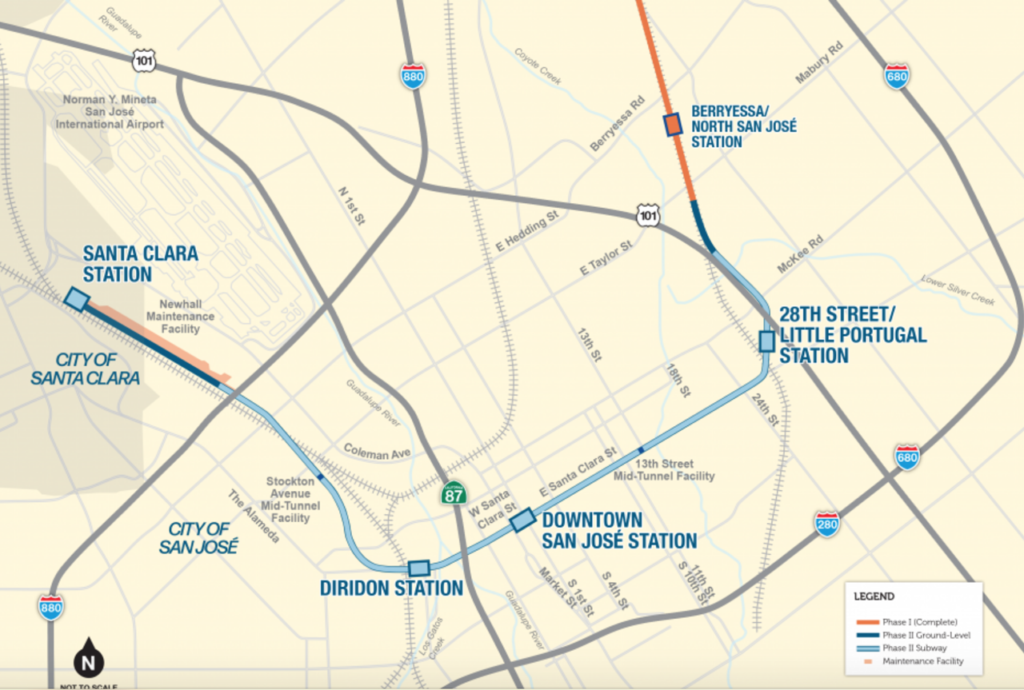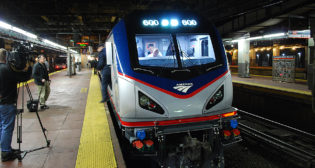
Independent Study OKs Single Bore Tunnel for BART Silicon Valley Phase II
Written by Marybeth Luczak, Executive Editor![SCVTA said its use of a single bore approach to build the six-mile, four-station BART Silicon Valley Phase II extension “will save construction time, reduce the station footprint and property needs, increase the potential for transit-oriented development, [and] reduce disruption to city streets, neighborhoods, and businesses.” (Rendering Courtesy of SCVTA)](https://www.railwayage.com/wp-content/uploads/2022/11/SCVTA-1.png)
SCVTA said its use of a single bore approach to build the six-mile, four-station BART Silicon Valley Phase II extension “will save construction time, reduce the station footprint and property needs, increase the potential for transit-oriented development, [and] reduce disruption to city streets, neighborhoods, and businesses.” (Rendering Courtesy of SCVTA)
An independent study has confirmed that the single bore tunnel method is feasible for the BART (Bay Area Rapid Transit) Silicon Valley Phase II project, according to Santa Clara Valley Transportation Authority (SCVTA).
The six-mile extension project in California—which includes three underground stations (28th Street/Little Portugal, Downtown San José, and Diridon), one at-grade station (Santa Clara), a maintenance facility, and five miles of subway tunnel—will expand BART service from the Berryessa Transit Center in northeast San José through downtown San José into the city of Santa Clara (see map below). SCVTA is the funding agency and will manage the delivery of the project, while BART is system operator and maintainer. (The 10-mile BART Phase I Berryessa Extension Project opened in 2020; it begins south of BART’s Warm Springs Station in Fremont, proceeds through Milpitas and ends in the Berryessa area of north San José.)

SCVTA on Nov. 5 said that the results of an independent peer review—led by the American Public Transportation Association (APTA) and conducted by experts in tunneling, station architecture and project management—was presented at the Nov. 3 SCVTA Board Meeting (download presentation below). They show that the single bore tunnel method, along with some of the proposed designs, “is deemed to be feasible, appropriate, safe and efficient,” according to SCVTA, which noted that single bore tunnels “are increasingly being utilized for transit projects in Europe and Asia, with recent projects in Spain, France, Dubai and the Netherlands.”
SCVTA said its single bore approach to build the BART extension “will save construction time, reduce the station footprint and property needs, increase the potential for transit-oriented development, [and] reduce disruption to city streets, neighborhoods, and businesses,” as well as reduce “many of the environmental impacts occurring during construction.” Changing to a twin bore tunnel project, it noted, “would cause significant schedule delays and cost increases.”
The study included a “review of trade-offs between the single bore and twin bore designs related to safety, passenger experience, cost and schedule,” and was informed by project documents and past studies, recent global tunneling projects, and “a key proposed innovation” from Kiewit Shea Traylor (KST), the joint-venture contractor for the tunnel and trackwork, according to SCVTA.
KST has proposed a center boarding platform within the single bore tunnel (meaning, a platform between both directions of tracks) for all three underground stations. This would allow for side-by-side tracks (rather than a stacked-track plan) for the entire extension; a shallower descent to the platform from the street level; and potential access to the boarding platforms from both sides of Santa Clara Street, in downtown San Jose, according to SCVTA. It would also facilitate “smaller adits, reducing construction risk and extent and cost of ground treatment”; cause a “slight increase in tunnel diameter, but no appreciable risk increase”; and enhance the “passenger experience by reducing vertical access and providing an island platform,” according to SCVTA.
SCVTA said it engaged APTA to coordinate the independent review of the project’s tunneling method as part of a design review request from VTA Board member and San Jose Mayor Sam Liccardo, approved in May by the VTA Board. The findings of a previous independent comparative analysis of both tunneling methods in 2017—the 2017 SVSX Single Bore Feasibility Study—helped lead to the single bore approach and current concept, according to the transit agency.
“We are pleased that our design and engineering plans have received this important review and endorsement,” SCVTA General Manager and CEO Carolyn Gonot said. “This confirmation fuels us to push ahead with the most important transportation project in our region, bringing BART around the bay through Silicon Valley.”



